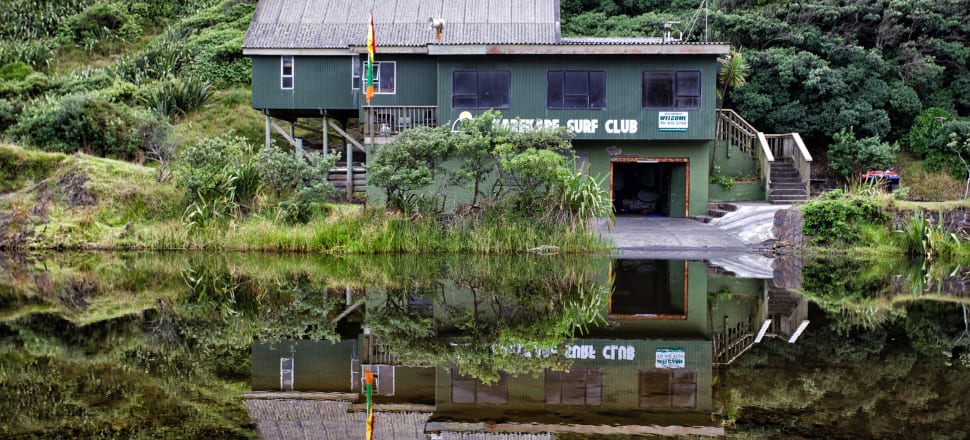
Uncertainty abounds on the west coast, where post-cyclone land instability puts whole communities in doubt despite council buyouts
Community-led advocacy groups for cyclone-affected areas on Auckland's west coast are calling for a “reset” on risk categorisation processes.
Paul Dudfield, a Karekare resident and member of one such group, said current categorisation processes failed to take into account the impact of even category 1 and 2 levels of risk on future property value.
READ MORE:
* Karekare digs itself out
* Protecting Auckland may require unpopular changes
He said the current system threatened to level the community, with some people fleeing the community and others trapped in properties with unstable land that don’t reach the threshold of council buyouts.
Auckland Council recently confirmed Category 2P, in which it would pay for up to a quarter of a property’s CV for feasible mitigations of disaster risk that can be completed within two years.
Deputy group recovery manager Mace Ward said the council recognised for many homeowners, paying for mitigation work to protect their home from flooding or landslide would be out of reach.
“There are two things we need to consider for these mitigations. Firstly, is whether intervention works are technically possible. For example, that means looking at whether there’s enough space to construct a retaining wall, or whether the nature of the house means it can actually be raised," he said.
“The second part to feasibility is whether it’s affordable and if it can be delivered in a reasonable timeframe. Whilst anything is possible if you have enough money, we needed to put a realistic and responsible cap on what could be spent on a mitigation.”

For some property owners, the ability to feasibly mitigate risk dashes hopes of a full buyout.
Dudfield said for some in his community, that outcome would be replaced by mitigations that wouldn’t be able to fully solve land instability issues or the ensuing impact they may have on land value or ability to get consents.
“They’re trapped,” Dudfield said. “It’s not like they’re going to be building the Great Wall of China up behind us, so it’s all just property-by-property stuff.”
Dudfield characterised the current approach as attempting to be one-size-fits-all and feeding into a vicious circle where property owners may struggle to get insurance, and if uninsured will be ineligible for EQC settlements.
And in areas like Karekare, exposed to the coastal elements while clinging to the heavily forested hills of the Waitakere Ranges, mitigation isn’t likely to be cheap.
Dudfield said in many cases heavy machinery wouldn’t be able to access sloped and heavily native vegetated properties – conditions found on most Karekare properties.
With a population of 320, Karekare is a singular example of a community within Auckland dealing with its own difficult post-Cyclone recovery.
Along with other beach towns such as Muriwai and Piha further up the coast, Karekare was built on a mixture of sometimes loosely deposited sand dunes and rock.
Karekare in particular has limited access, with two narrow and winding roads providing the only vehicular access.
After being cut off following Cyclone Gabrielle, Karekare residents took it upon themselves to dig their way out, sending Auckland Transport the bill later.
But even as access is restored to the community, its continued existence as it currently stands is in question without promises from Auckland Council and private insurance companies.
“At the moment it’s really a one-size-fits-all,” he said. “But here in Karekare, we’ve got nowhere to go – we can’t just go to another street. It’s already having a huge impact on the community. Some people have left, while certain people here will stay basically trapped.”
Dudfield said recovery would only work when all of the jigsaw pieces were put together properly.
“We need a collective vision on this,” he said. “This is the backyard to 1.6 million people. It’s an unspoiled paradise, and we are the stewards here, but that means we’ve been doing the mahi.”
Groups from Piha, Karekare and Anawhata invited politicians to Barnett Hall in Piha on Sunday afternoon to talk about what to do next.
In attendance were Kaipara ki Mahurangi MP Chris Penk, former New Lynn MP Deborah Russell, and her successor, National’s Paulo Garcia.
Garcia said it had been a very difficult time for west coast communities and the unprecedented level of geotechnical assessment had been slow-going.
"The big question for everybody in category 2 is how much are the mitigations going to cost and how much will insurance pay?" he said. "At least if you're in category 3 you know you'll be bought out."
An equally split $774 million from central and local government has already been pledged to buy out the owners of an estimated 700 residential properties across Auckland.
But there’s a strict criteria on this – there must be a proven intolerable risk to life that is impossible to reduce. This is determined after an in-depth assessment that looks at property information, predictive modelling data and on-site inspections.
Some 7000 properties in the region needed these assessments, while out on the west coast there was also a need for a number of geotechnical surveys.
A shortage of geotechnical engineers immediately after the cyclone has slowed this process, but the council has indicated the surveys in Karekare should be done by the end of November.
Garcia said it had been a "limbo-land" for those on the threshold between categories.
"Sometimes the mitigation requires a different property fixing something," he said. "And the bottom line is that whatever mitigation happens will go on people's LIM reports, and everybody is conscious about how that impacts the saleability of the property."
Dudfield said the community was worried their land value would be devastated without any meaningful help from council or government should damaged properties not meet the high threshold for risk to life.
“It’s a massive exercise in the transfer of liability from the council to property owners,” he said.







